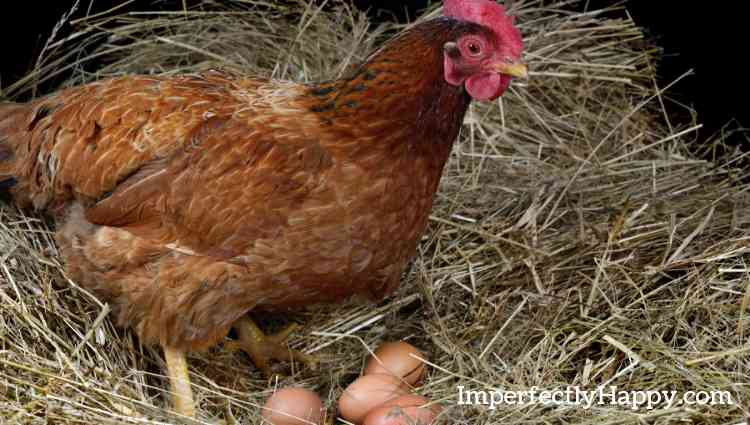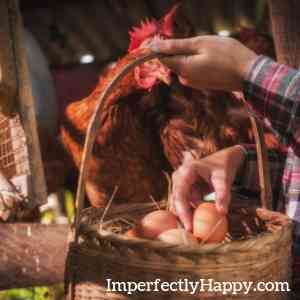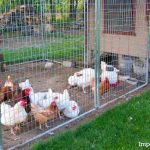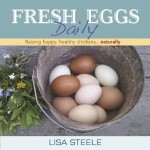What to do about chicken nesting boxes and materials is a question I hear from a lot of my readers. So today I want to go over the tips and tricks I’ve learned about chicken nesting boxes over the years. I am also going to share some simple DIY chicken nesting boxes you can make yourself and save some money (win!).

Your Guide to the Best Chicken Nesting Boxes
Let’s go over a few basics you need to know about how chickens prefer to lay eggs and nesting boxes 101. These are important considerations for chicken nesting boxes because this is what will keep your hen laying daily for as long as possible!
Chicken Nesting Boxes Tips

Your hen wants privacy above all else. Remember she believes she is laying eggs that will hatch so safety is number one. Nesting boxes provide your hens a place to lay, making it easier for you to collect the eggs vs letting them lay where ever they please.You want your nesting boxes to be:
- Not too much light
- Private
- Quiet
- Safe (away from other animals)
- Clean and fresh
- Generally you want to place your chicken’s nesting box in her coop
Best Material for Chicken Nesting Boxes
Whether you decided to construct your own nesting boxes or buy a pre-made box, there are some considerations to keep in my. The biggest concern is being able to keep your nesting box clean. So you want to pick a box or materials to make one that can be washed, scrubbed and sterilized.
Wood Nesting Boxes
You’ll often see chicken nesting boxes made of wood, which isn’t awful; but cleaning it will break it down over time. And I worry that it can’t really be sterilized efficiently. You can find these pre-made wooden boxes or free plans for you own.
See More DIY Chicken Nesting Boxes Here
Metal Nesting Boxes
Metal can be a great option because it is easier to keep clean and will last longer than most other materials. I do caution you to be wary of metal boxes if you live in an area that gets very hot during the summer. Here in Phoenix a metal box would make our hens miserable. See these options: 2 hole metal nesting box, 2 hole vertical nesting box and 10 hole metal nesting box for large coops.
Plastic Nesting Boxes
Chicken nesting boxes made of plastic have some real advantages too. First, they are easily cleaned and sterilized. They are usually less expensive than their metal counterparts and won’t heat up as much in the summer. They do risk the wearing down in direct sun though, so that should be a consideration. Check out these plastic options:
Poly Egg Nesting Boxes, 6 pack
Wall Mounted Nesting Box, 2 pack
Best Bedding Material For Chicken Nesting Boxes
Bedding really does matter for your chicken nesting boxes. Of course we want our laying hens to be comfortable but most importantly we want them to be healthy.
- Nest Liners – I love the pre-made nest liners and have been using them for years. These provide a clean nest for the girls and ease for me. But they are consumable so not always the best economical choice. However I do add them to my compost so that’s a win!
- Reusable Nest Liners – These washable nest liners are a great option for reusable, easy to clean and ready-made nest materials.
- Straw or Hay – a great affordable option for your chicken nesting boxes is simply using straw or hay. It has a great sweet aroma, ok for the hens to eat and can be bought in bulk for a savings.
- Wood Shavings – most popular would be pine or cedar shavings. I like that shavings offer a pleasant aroma and general dry quickly. They can be pricey if you’re getting them at a pet store so shop around! You should check out Fresh Eggs Daily’s post on Straw vs Shavings for more information.
- Yard Waste – I have seen a few people recommend using fallen leaves or grass clippings as chicken nesting materials. This is definitely a no-cost option but I caution you to be careful of your source. Trees and grass are often treated with chemicals and we don’t want that around our hens! These are also not the most absorbent materials so you’ll need to change them often.
- Sand – It can be a great option for ease of clean up and quick to dry. However sand does heat up so it would not be a great option for hot climates. It also does not offer the comfort to your hen that the other nesting box materials will. Be VERY careful with using fine sand that can cause respiratory issues.
Herbs for Chicken Nesting Boxes
Have you considered herbs for your chicken nesting boxes? Herbs aren’t just a way to add a scent to the coop, they have some important contributions to health and wellness for your laying hens too.
Here are a few popular herbs that can benefit your hens when added to their nests.
Basil – Has a calming effect
Catnip – Can be an effective insect repellent
Dill – Improves chicken respiratory health and can also be calming
Fennel – Can increase laying in hens
Lavender- Relaxing, smells wonderful and can in increases blood circulation
Lemon Balm – Relaxing and can deter rats and mic
How to have a Rodent Free Coop
Marigolds – Helps to keep insects at bay.
Mint – Rodent and insect repellent, smells wonderful
Nettles – Relaxing
Parsley – Vitamin boost
Rose Petals – Calming and aromatic (make sure they are pesticide free)
Thyme – Great for respiratory health
Yarrow- Reduces stress
If you don’t want to collect all these herbs yourself there are great pre-made options available especially made for chicken nesting boxes.
Chicken Nesting Boxes Questions
How Many Hens Per Nesting Box?
This is a highly debatable topic but I’ll give you my opinion, based on my backyard hens. I have often found that one box for every 4 – 5 hens is sufficient. And what is really funny is that even when I had 1 box PER HEN, they often all laid in the same box. I would laugh to see them upset when their favorite nesting box was already occupied! What a ruckus!
How do I get my hens to lay in nesting boxes?
If you follow all of the above suggestions the likelihood is your hens will lay there without any coaxing from you. However if you find that they are laying outside of your offerings here are a few tricks to try:
- Put a fake egg in the boxes to give them the idea that this is a preferred laying area.
- If they are free range hens you might want to wait until they’ve laid (mid-morning) before letting them out of the coop.
Final Word on Chicken Nesting Boxes
Hens are animals like like clean and safe environments for laying. Provide them nesting boxes that meet those two requirements and you won’t have to worry about much else. Sure, there may be an occasional stray layer but you can usually get her back on track with a little training.
Take good care of your girls, and they’ll provide healthy and delicious eggs for years.




